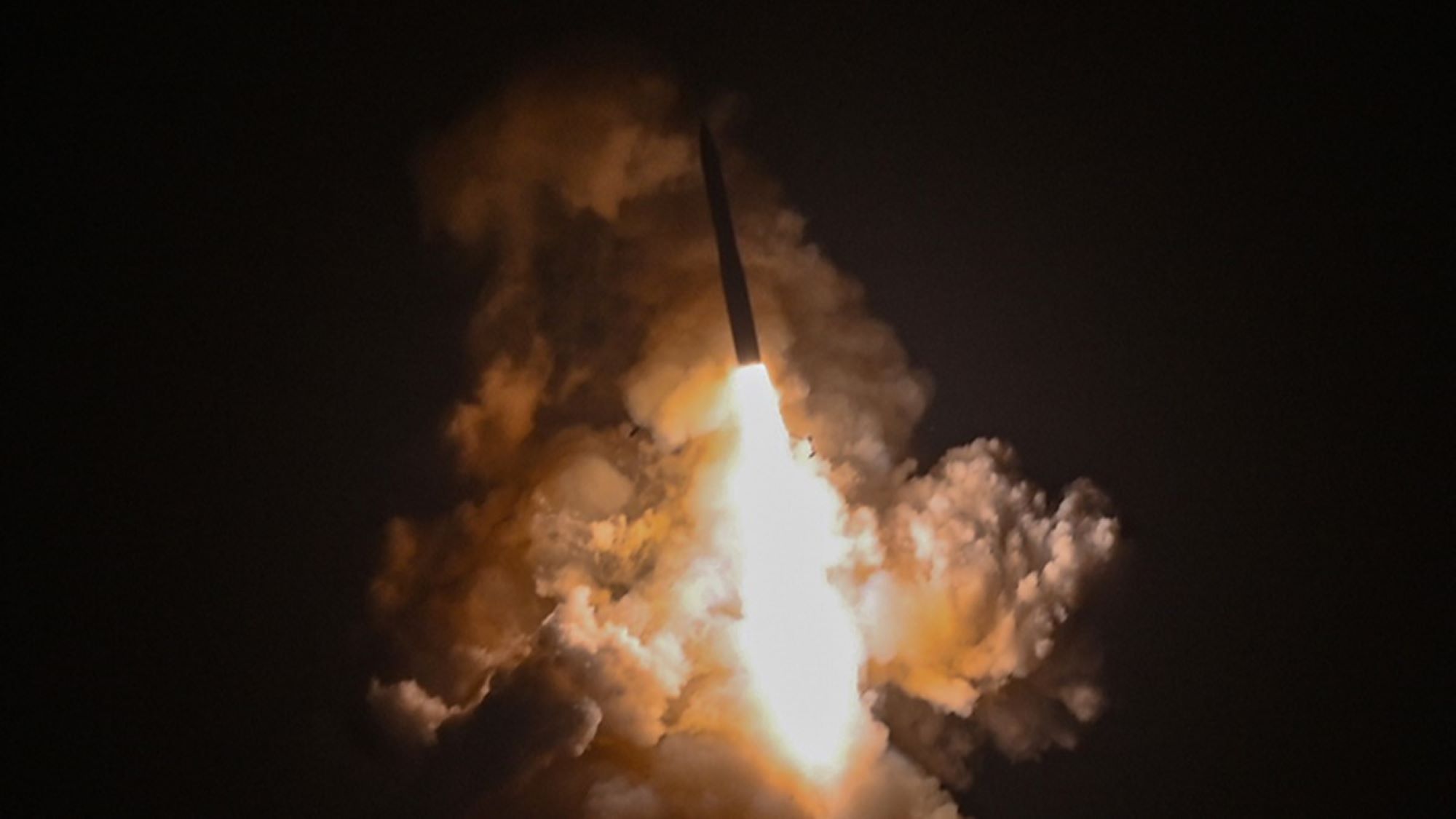The D Brief: USFK to shrink?; House passes spending bill; Big AI in a laptop?; Russia’s big security-camera hack; And a bit more.
The Trump administration is considering shifting 4,500 troops from South Korea to other locations across the Pacific, including Guam, the Wall Street Journal reported Thursday. Context: The Trump team is looking to reduce U.S. troop levels in Europe and the related focus on Russia’s Ukraine invasion, ostensibly to prepare for a possible conflict with China, as NBC News reported last month, citing administration officials. Korea caveat: “U.S. officials say a decision on troop levels won’t come until there is more clarity about the direction of the war in Ukraine and whether the administration will keep supporting Kyiv militarily,” the Journal reports. From the Pacific region: The U.S. Army’s 25th Infantry Division recently tested new vehicles and drones during exercises in the Philippines, Defense One’s Meghann Myers reported Thursday. Why it matters: Soldiers are still trying to figure out how much equipment they can load onto their new infantry squad vehicles and still get it all up a muddy hill in the jungle. And when it comes to drone operations, high humidity and daily rain are a major consideration in the Pacific, which poses some different challenges than Europe’s occasionally more mountainous terrain, as discussed in one of our recent podcasts on the Army’s new Transformation-in-Contact program. “Some of the optics sometimes might be degraded because of [rain and humidity], but that's what we're figuring out,” Sgt. Maj. Stephen Siglock, 25th ID’s operations sergeant major, told Myers. “I've seen our medium-range reconnaissance drones fly in fairly heavy rain and still be not as effective, but effective. Obviously, it will limit the range and somewhat degrade the optics,” he said. Notable: For INDOPACOM, small drones are particularly useful for infantry units needing to get eyes across the water, because they can’t just send scouts on ground vehicles from island to island, Myers reports. Read on, here. Related reading: “Philippine Navy Commissions Missile Frigate, Showcases American USVs,” the U.S. Naval Institute News reported Thursday. Trump’s Pentagon just greenlit another 1,100 or so troops to deploy along the southern border with Mexico, Military Times reported Thursday. “The additional 1,100 would bring the military close to the 10,000 total that Defense Secretary Pete Hegseth approved for the border mission earlier this year.” Around 8,000 active duty troops are on location presently. In photos: Check out around a dozen images of American troops operating in a variety of capacities along the Mexico border via this photoset posted by the Defense Department two weeks ago. From Capitol Hill: The House just passed its reconciliation bill with $150 billion for defense, Breaking Defense reported Thursday. The vote was extremely close at 215-214-1; but procedural mechanics will likely allow the GOP-controlled Senate to pass their version of the bill without support from Democrats. Forecast: “The Trump administration hopes to push $113 billion of the $150 billion pot into Pentagon coffers in fiscal year 2026—resulting in a $1 trillion total payout for defense spending that also allows fiscal hawks to keep the defense base budget completely flat,” BD’s Valerie Insinna writes. Read more, here. Developing: A new bill, the Joint Reserve Detachment Formalization Act, aims to lock in DIU’s dual-use reservist corps, Defense One’s Patrick Tucker reported Friday. The Joint Reserve Detachment (JRD) Formalization Act would amend Title 10 of the U.S. Code to mandate what has until now been voluntary. The bill changes a single phrase in Section 1766(a) from “may establish” to “shall establish and maintain,” making it a legal requirement for the Secretary of Defense to sustain the JRD as a permanent component of DIU, according to the bill’s text. This linguistic pivot could have larger implications, Tucker writes. The current legal framing allows DIU—an organization tasked with accelerating the adoption of commercial technology across the Department of Defense—to build a part-time force of tech-savvy reservists if it chooses. The proposed change would require it to do so, requiring what has been, until now, a discretionary experiment. Read on, here. Developing: The U.S. military is working on ways to get the power of cloud-based, big-data AI into tools that can run on local computers. The idea is to draw upon more focused data sets, and remain safe from spying eyes, officials from OpenAI, Scale AI, and U.S. European Command told Defense One in a special “Genius Machines” broadcast that aired Thursday. How it might work: When civilians query OpenAI’s ChatGPT, for example, their answers are generated by machines trained on huge amounts of data acquired from third-party sources and millions of user interactions a day. But the government has also hired OpenAI to make need-specific tools built on smaller and more unique datasets, said Sasha Baker, OpenAI’s head of national security policy. Ba

Context: The Trump team is looking to reduce U.S. troop levels in Europe and the related focus on Russia’s Ukraine invasion, ostensibly to prepare for a possible conflict with China, as NBC News reported last month, citing administration officials.
Korea caveat: “U.S. officials say a decision on troop levels won’t come until there is more clarity about the direction of the war in Ukraine and whether the administration will keep supporting Kyiv militarily,” the Journal reports.
From the Pacific region: The U.S. Army’s 25th Infantry Division recently tested new vehicles and drones during exercises in the Philippines, Defense One’s Meghann Myers reported Thursday.
Why it matters: Soldiers are still trying to figure out how much equipment they can load onto their new infantry squad vehicles and still get it all up a muddy hill in the jungle.
And when it comes to drone operations, high humidity and daily rain are a major consideration in the Pacific, which poses some different challenges than Europe’s occasionally more mountainous terrain, as discussed in one of our recent podcasts on the Army’s new Transformation-in-Contact program. “Some of the optics sometimes might be degraded because of [rain and humidity], but that's what we're figuring out,” Sgt. Maj. Stephen Siglock, 25th ID’s operations sergeant major, told Myers.
“I've seen our medium-range reconnaissance drones fly in fairly heavy rain and still be not as effective, but effective. Obviously, it will limit the range and somewhat degrade the optics,” he said.
Notable: For INDOPACOM, small drones are particularly useful for infantry units needing to get eyes across the water, because they can’t just send scouts on ground vehicles from island to island, Myers reports. Read on, here.
Related reading: “Philippine Navy Commissions Missile Frigate, Showcases American USVs,” the U.S. Naval Institute News reported Thursday.
Trump’s Pentagon just greenlit another 1,100 or so troops to deploy along the southern border with Mexico, Military Times reported Thursday. “The additional 1,100 would bring the military close to the 10,000 total that Defense Secretary Pete Hegseth approved for the border mission earlier this year.” Around 8,000 active duty troops are on location presently.
In photos: Check out around a dozen images of American troops operating in a variety of capacities along the Mexico border via this photoset posted by the Defense Department two weeks ago.
From Capitol Hill: The House just passed its reconciliation bill with $150 billion for defense, Breaking Defense reported Thursday. The vote was extremely close at 215-214-1; but procedural mechanics will likely allow the GOP-controlled Senate to pass their version of the bill without support from Democrats.
Forecast: “The Trump administration hopes to push $113 billion of the $150 billion pot into Pentagon coffers in fiscal year 2026—resulting in a $1 trillion total payout for defense spending that also allows fiscal hawks to keep the defense base budget completely flat,” BD’s Valerie Insinna writes. Read more, here.
Developing: A new bill, the Joint Reserve Detachment Formalization Act, aims to lock in DIU’s dual-use reservist corps, Defense One’s Patrick Tucker reported Friday. The Joint Reserve Detachment (JRD) Formalization Act would amend Title 10 of the U.S. Code to mandate what has until now been voluntary.
The bill changes a single phrase in Section 1766(a) from “may establish” to “shall establish and maintain,” making it a legal requirement for the Secretary of Defense to sustain the JRD as a permanent component of DIU, according to the bill’s text.
This linguistic pivot could have larger implications, Tucker writes. The current legal framing allows DIU—an organization tasked with accelerating the adoption of commercial technology across the Department of Defense—to build a part-time force of tech-savvy reservists if it chooses. The proposed change would require it to do so, requiring what has been, until now, a discretionary experiment. Read on, here.
Developing: The U.S. military is working on ways to get the power of cloud-based, big-data AI into tools that can run on local computers. The idea is to draw upon more focused data sets, and remain safe from spying eyes, officials from OpenAI, Scale AI, and U.S. European Command told Defense One in a special “Genius Machines” broadcast that aired Thursday.
How it might work: When civilians query OpenAI’s ChatGPT, for example, their answers are generated by machines trained on huge amounts of data acquired from third-party sources and millions of user interactions a day. But the government has also hired OpenAI to make need-specific tools built on smaller and more unique datasets, said Sasha Baker, OpenAI’s head of national security policy. Baker cited the company’s recent work for U.S. national laboratories on nuclear weapons safety.
Why OpenAI? The company spearheaded a new form of generative AI that feels like a large language model trained on massive public datasets but that does not need to reach beyond a secure perimeter and perform tasks far more complex than writing a white paper or developing a business plan. Continue reading, here.
Additional reading:
- “Anthropic's new AI model turns to blackmail when engineers try to take it offline,” TechCrunch reported Thursday;
- “Sailor arrested for allegedly making false bomb threat on plane,” Navy Times reported Thursday.
- “L3 Technologies Inc. Agrees to Pay $62,000,000 to Resolve False Claims Act Allegations,” the Justice Department announced Thursday;
- And “An 18th-century war power resurfaces in cyber policy talks,” Nextgov/FCW reported Thursday.
Welcome to this Friday edition of The D Brief, a newsletter dedicated to developments affecting the future of U.S. national security, brought to you by Ben Watson and Bradley Peniston. Share your tips and feedback here. And if you’re not already subscribed, you can do that here. On this day in 1939, Navy submarine USS Squalus sank off the coast of New Hampshire during a test dive when a malfunction flooded a portion of the sub; 26 people died, but 33 were rescued the next day thanks to a new device called the McCann Rescue Chamber. Four Navy divers—Chief Machinist's Mate William Badders, Chief Boatswain's Mate Orson L. Crandall, Chief Metalsmith James H. McDonald, and Chief Torpedoman John Mihalowski—were awarded the Medal of Honor for their role rescuing the 33 surviving crew members.
Trump 2.0
New: Most major agencies are now indefinitely barred from issuing mass layoffs. The Trump administration is indefinitely barred from issuing or finalizing widespread layoffs at most major federal agencies after a judge late Thursday night issued a preliminary injunction finding the president likely acted outside his legal and constitutional powers, Eric Katz of Government Executive reports.
The order specifically pauses any implementation related to Agency RIF and Reorganization Plans, which the deciding judge described as “hastily constructed and likely unconstitutional.”
The order applies to the departments of Agriculture, Commerce, Energy, Health and Human Services, Housing and Urban Development, Interior, Labor, State, Treasury, Transportation and Veterans Affairs, as well as also OMB, OPM, DOGE, AmeriCorps, Peace Corps, the Environmental Protection Agency, the General Services Administration, the National Labor Relations Board, the National Science Foundation, the Small Business Administration and the Social Security Administration. Read more at NBC or the Washington Post.
Developing: Booz Allen Hamilton plans to lay off roughly 7% of its workforce amid a government-wide push to reduce spending on contracts, Washington Technology reported Friday.
Trump’s spy chief is looking for a “One-Stop Shop to Buy Your Most Sensitive Personal Data,” the Intercept reported Thursday, citing contract documents. “The documents state spy agencies will use the web portal not just to search through reams of private data, but also run them through artificial intelligence tools for further analysis,” Sam Biddle reports.
“It will be designed for the 18 different federal agencies and offices that make up the U.S. intelligence community, including the National Security Agency, CIA, FBI Intelligence Branch, and Homeland Security’s Office of Intelligence and Analysis—though one document suggests the portal will also be used by agencies not directly related to intelligence or defense.”
From ODNI’s perspective, they want to “streamline a number of inefficient processes, including duplicative contracts to access existing data, and ensuring Americans civil liberties and Fourth Amendment rights are upheld,” spokesperson Olivia Coleman said in a statement.
If you’re just catching up to this issue, “Spy agencies and military intelligence offices have for years freely purchased sensitive personal information rather than obtain it by dint of a judge’s sign-off,” Biddle writes. “Thanks largely to unscrupulous advertisers and app-makers working in a regulatory vacuum, it’s trivial to procure extremely sensitive information about virtually anyone with an online presence.” Read on, here.
Additional reading:
- Learn about “The Gang-Linked Prison Chief Taking Custody of Trump’s Deportees,” via the Wall Street Journal, reporting Thursday;
- “President Trump Has Cut Science Funding to Its Lowest Level in Decades,” the New York Times reported with illustrating charts Thursday;
- And a “‘Hidden’ provision in Trump's big bill could disarm US Supreme Court,” Newsweek reported Thursday.
Putin’s Ukraine invasion
To learn what the West is shipping to Ukraine, Russian hackers have been targeting logistics firms, US intelligence says. The efforts began in 2022, the year Russia launched its full-scale invasion, according to a new report issued jointly by a host of U.S. and allied intelligence agencies.
The campaign, which involved the Russian hacking collective Fancy Bear, sought to penetrate defense, transportation and logistics companies in several Western countries, including the U.S., as well as ports, airports and rail systems,” AP reported.
“More than 10,000 internet-connected cameras were targeted, including private devices and public traffic cameras near critical transportation points, such as ports, rail hubs or border crossings. Most were in Ukraine, though some were in Romania, Poland and other eastern or central European countries.”
Grant Geyer, chief strategy officer at the cybersecurity company Claroty, told AP that spearphishing and other relatively simple techniques enabled “the sprawling yet carefully orchestrated effort” to give the Russians a “granular understanding” of the aid sent to Ukraine. Read on, here.
Related reading:
- “Russia’s major exporters cut rail cargo volumes as economy slows, document shows,” Reuters reported Friday;
- And “Germany set to defend NATO neighbours with new brigade in Lithuania,” Reuters reported Friday from Vilnius.






















































































































































